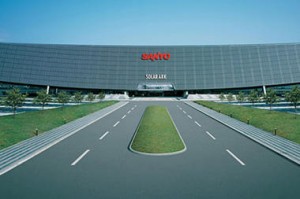SunPower Corp. has announced it has signed an agreement with Arizona Public Service (APS) to design and construct a 15-megawatt (AC) solar photovoltaic power system at Luke Air Force Base in Glendale, Arizona. Scheduled for completion in the summer of 2011, it is expected to be the largest solar power installation at a U.S. government facility. Approximately 550 local jobs will be created during construction.
“Installed on 101 acres of underutilized land, this system will generate the equivalent of 50 percent of the annual energy requirements for Luke Air Force Base,” said Air Force Lt. Col. John Thomas, 56th Civil Engineer Squadron commander at Luke. “Benefits of the project to the American taxpayers include no initial out-of-pocket expenses to the Air Force, significant long-term savings on electricity costs, and the increased energy independence associated with using reliable, emission-free solar power.”
“APS is committed to building a sustainable future, which includes the expansion of our renewable energy portfolio,” said Brad Albert, general manager of Renewable Energy and Resource Acquisition of APS. “This plant will not only bring more clean renewable energy to the grid, but will also create jobs during its construction.”
APS will own the system that SunPower designs, builds and maintains, and sell electricity to Luke Air Force Base under a long-term agreement. The system will use high-efficiency SunPower solar panels, the most efficient solar panels on the market, with the SunPower Tracker(R) system. The Tracker follows the sun’s movement during the day, increasing sunlight capture by up to 25 percent over conventional fixed-tilt systems, while significantly reducing land use requirements.
The system will generate the equivalent energy required for 3,750 Arizona homes, avoiding more than 19,000 metric tons of carbon dioxide emissions each year, according the U.S. Environmental Protection Agency estimates.
ORGANIC COSMETICS
San Francisco approves new Bicycle Plan
 San Francisco Bicycle Plan
San Francisco Bicycle Plan
Solar Waste Recycling: Can the industry stay green?
By Erica Gies
In recent years the electronics industry has gained notoriety for creating an endless stream of disposable products that make their way at life’s end to developing countries, where poor people without safety gear cut and burn out valuable materials, spilling contaminants into their water, air and lungs.
Solar modules contain some of the same potentially dangerous materials as electronics, including silicon tetrachloride, cadmium, selenium and sulfur hexafluoride, a potent greenhouse gas. So as solar moves from the fringe to the mainstream, insiders and watchdog groups are beginning to talk about producer responsibility and recycling in an attempt to sidestep the pitfalls of electronic waste and retain the industry’s green credibility.
Solar modules have an expected lifespan of at least 20 years so most have not yet reached the end of their useful lives. But now, before a significant number of dead panels pile up, is the perfect time to implement a responsible program, said Sheila Davis, executive director of the Silicon Valley Toxics Coalition. Read on
Colin McCrate, urban farmer
If there’s a vanguard for the back-to-the-future, “Victory Garden” era in horticulture and landscaping, Colin McCrate is leading it. As the recession stretches out, garden-happy Seattleites are switching flowerbeds and shrubs into edible greens, fruits, and vegetables. At McCrate’s Seattle Urban Farm Company, the requests for residential farm landscaping (and chicken coops) keep increasing.
“It’s definitely true,” said McCrate, atop Ballard’s Bastille restaurant (5307 Ballard Ave. N.W.), where he’s installed a prototype rooftop garden. “More and more people are taking advantage of yard space to supplement their food needs. The sale of vegetable seeds has gone through the roof.”
Seattle’s climate, even in a cloud-shrouded summer like the one we are currently experiencing, is perfect for cultivation of greens, herbs, vegetables and fruit, particularly native apples, cherries and plums. Rain and peek-a-boo sun makes for perfect growing conditions. Some local gardeners have always made a sport of growing food products, and Seattle’s P-Patch network has been flourishing since the hippie-intensive 1970s. But now, people are farming for keeps, both residentially and commercially.
“Our customers are constantly surprised at the yield from even a small plot,” McCrate commented.
A few years ago, Bastille’s James Weimann and Demming Maclise purchased a building on the resurgent Ballard Avenue. (If you haven’t been over there recently, make plans. It’s as nice a mix of retail and restaurants in the city). Their goal was to create a restaurant that adhered to the strict demands of French cuisine, namely the use of fresh ingredients. They succeeded in spades, but not before an intensive remodel and some bold thinking. Weimann and Maclise hit on the idea of a rooftop garden. What could be fresher than the harvest from a two-flight walk-up garden?
McCrate, who designed the innovative rooftop beds for Bastille’s produce, estimates that with 800 square feet of garden, the restaurant is currently meeting about 30 to 40 percent of its needs for fresh greens and herbs, including red leaf lettuce, Miner’s lettuce, arugula and peppercress. “They are, however, getting 100 percent of their basil and rosemary needs, which both do very well in Seattle.”
Weimann and Maclise may not see a positive return on their investment for a number of years, but patrons get an immediate, positive return in every bite. And as innovators in the rooftop garden field, they’ve been raking in the media coverage. The garden is “poised to become a Seattle landmark,” said Eat, Drink and Be. Bastille is not the only restaurant or urban enterprise doing a bit of intensive farming. Venerable Canlis has a terraced garden in its North Queen Anne Hill location, and, two years ago, Maggie McKelvy, a manager of HomeStreet Bank’s Ballard branch, led an effort to turn a bed in the bank’s parking lot into a vegetable-producing space.
McCrate believes efforts like these are just the first steps of a widespread movement to reclaim food. It’s hard to argue with him. Just two years ago, separate incidents with contaminated lettuce and cilantro generated a great amount of fear about the safety of our industrial-strength food chain, and the quality of produce like greens, fruits and vegetables that should be served as fresh as possible.
“Producing your own food allows for a measure of security,” said McCrate. “Anyone can plant a vegetable bed or a fruit tree. It takes no more water or soil than a flower bed, looks almost as beautiful in the yard, and produces a tangible and edible benefits.
SANYO SOLAR MUSEUM
Sanyo’s 1,033-foot- wide solar-powered museum in central Japan is composed of thousands of factory-recalled solar cells recycled from the company’s junk piles – a rare fusion of budgetary restraint, ecological awareness, and aesthetic design.
Let the iPhone Save the Planet
______________
Visit Pie Ranch

WHAT’S INSIDE
SUBSCRIBE TO UPDATES HERE
NEW! ECO TRAVEL
NEW: ORGANIC
NEW! WIND & WAVES
INSIGHT –
N THE MIX – webcasts
 TV
TV
VIDEO -
QUESTPOINT GOES MOBILE – Beta
Just log in from your iPhone, Blackberry or mobile device to get the latest stories, audio and video.




